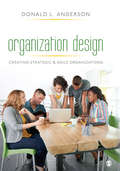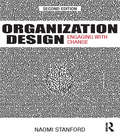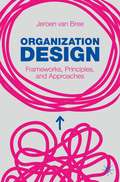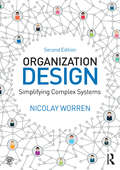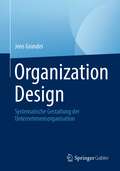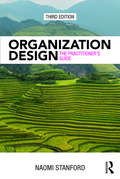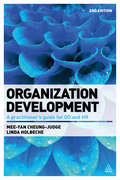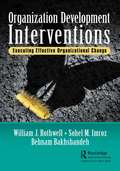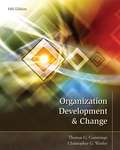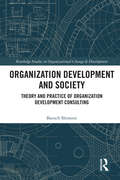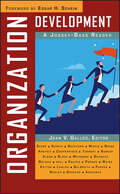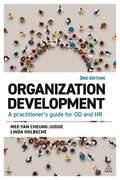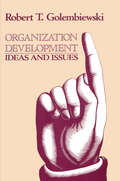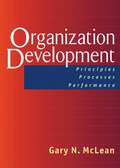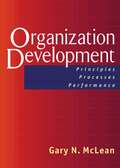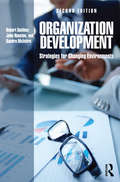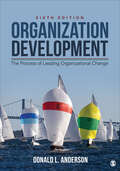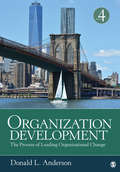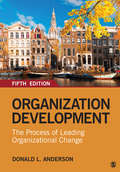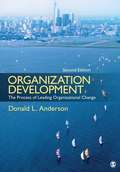- Table View
- List View
Organization Design: Creating Strategic & Agile Organizations
by Dr Donald L. AndersonTo thrive in today’s rapidly changing, global, dynamic business environment characterized by constant change and disruption, organizations must be able to adapt and innovate to maintain their competitive edge. Organization Design: Creating Strategic & Agile Organizations prepares students to make smart strategic decisions when designing and redesigning organizations. Structured around Galbraith’s Star Model™, the text explores five facets of organization design: strategy, structure, processes, people, and rewards. Author Donald L. Anderson distills contemporary and classic research into practical applications and best practices. Cases, exercises, and a simulation activity provide multiple opportunities for students to practice making design decisions. Includes an innovative organization design simulation activity that puts students in the role of a design practitioner!
Organization Design: Creating Strategic & Agile Organizations
by Dr Donald L. AndersonTo thrive in today’s rapidly changing, global, dynamic business environment characterized by constant change and disruption, organizations must be able to adapt and innovate to maintain their competitive edge. Organization Design: Creating Strategic & Agile Organizations prepares students to make smart strategic decisions when designing and redesigning organizations. Structured around Galbraith’s Star Model™, the text explores five facets of organization design: strategy, structure, processes, people, and rewards. Author Donald L. Anderson distills contemporary and classic research into practical applications and best practices. Cases, exercises, and a simulation activity provide multiple opportunities for students to practice making design decisions. Includes an innovative organization design simulation activity that puts students in the role of a design practitioner!
Organization Design: Engaging with Change
by Naomi StanfordAs the purse strings tighten company costs need to be cut without this affecting performance or sales. A common solution to this problem is to restructure the organization of the company i.e. adjust the lines and boxes on the organization chart with the aim of setting it up for high performance. This inevitably fails because an organization is a system; change one aspect and other facets will also change. Organization Design: Engaging with change looks at how to (re) design the organizational system in order to increase productivity, performance and value; providing the knowledge and methodology to design an agile organization capable of handling the kind of continuous organizational change that all businesses face. The book clarifies why and how organizations need to be in a state of readiness to design or redesign and emphasizes that people as well as business processes must be part of design considerations. Responding to developments across the world since the first edition, this book covers, among other topics: Technology changes that have impacted upon organizations Increased demands for ‘sustainability’ and corporate social responsibility The pressure on organizations to be smarter, more efficient and more effective Whilst the material on this subject targets a wide management audience, this book is specifically written for consultants, OD/HR practitioners and line managers working together to achieve the goal of organizational redesign for changing circumstances. Aided by a range of pedagogical features, this book is a must-read for students or practitioners involved in the field of organizational design, development and change.
Organization Design: Fashion or Fit?
by Henry MintzbergThe characteristics of organizations fall into one of five natural configurations, each a combination of certain elements of structure and situation. The five configurations are the simple structure, machine bureaucracy, professional bureaucracy, divisionalized form, and adhocracy. These five configurations serve as an effective tool in diagnosing the problems of organizational design.
Organization Design: Frameworks, Principles, and Approaches
by Jeroen van BreeThis upper-level textbook provides a practical guide to the field of organization design, grounded in academic literature. It is set apart from other books on the topic by its commitment to be relevant to Master’s students, as well as practitioners looking for evidence-based guidance. The book provides a solid theoretical background for students, defining what organization design is, exploring the history of the field, and describing established frameworks and theories. It then investigates why organizations may seek to embark on a re-design, and what a well-designed organization looks like, referencing case studies and the author’s own research. From there, it takes students through how organization design occurs, examining various models for intervention, the core steps in designing an organization, and what challenges a practitioner may face, all illustrated by stories from the field. This book includes a wide range of didactic elements for students, including learning objectives, case study examples, review questions, and further reading. It examines the impact of new ways of organizing, and draws on the author’s years of experience as a consultant to ensure that academic theory is seamlessly melded with practical application.
Organization Design: Simplifying complex systems
by Nicolay WorrenA well-designed organization is an effective organization. Decisions about organization design determine the shape and form of the organization – not only the reporting structure and authority relations, but also the number and size of sub-units and the interfaces between the sub-units. Indirectly, such decisions affect individual productivity as well as the organization’s ability to attain strategic goals. ??? Organization Design equips the reader with advanced tools and frameworks, based on both research and practical experience, for understanding and re-designing organizations. Particular emphasis is placed on how one can improve effectiveness by simplifying complex roles, processes, and structures. ??? Readers will find thorough conceptual explanations combined with examples from different industries. This updated second edition includes a new chapter about traditional organizational forms, and is complemented by a companion website. This textbook will be essential reading for students, scholars, and practitioners.
Organization Design: Systematische Gestaltung der Unternehmensorganisation
by Jens GrundeiDieses Fachbuch bietet einen fundierten Ansatz zur Lösung praktischer Organisationsprobleme, mit denen Manager und Berater häufig konfrontiert werden. Es wird zunächst gezeigt, wie Organisationsfragen als Management-Entscheidungsprobleme verstanden und einer konsequenten Steuerung zugänglich gemacht werden können. An die Eingrenzung des Gegenstands von Reorganisationen schließt sich eine eingehende Erläuterung geeigneter Beurteilungskriterien für Organisationsstrukturen an. Sodann werden die Kernalternativen der organisatorischen Gestaltung erläutert, bevor exemplarisch gezeigt wird, wie sich konkrete Organisationsformen anhand der Kriterien beurteilen lassen. Neue Organisationsformen werden dabei jeweils explizit berücksichtigt. Für die Auswahl einer zweckmäßigen Organisation wird abschließend auf die strategiebasierte Gewichtung von Organisationszielen sowie die Integration der sachlogischen und verhaltensorientierten Beurteilungsperspektive eingegangen. Zahlreiche Praxisbeispiele sowie Definitionen wichtiger Begriffe, Merksätze und Hintergrundinformationen erleichtern die Umsetzung in die Unternehmenspraxis.
Organization Design: The Practitioner’s Guide
by Naomi StanfordOrganization Design looks at how to (re)design an organizational system in order to increase productivity, performance and value, and provides the knowledge and methodology to design an adaptive, agile organization capable of handling the kind of continuous organizational change that all businesses face. The book clarifies why and how organizations need to be in a state of readiness to design or redesign, and emphasizes that people as well as business processes must be part of design considerations. With an enhanced international focus, this third edition includes new material on: organization design theories designing ethical, diverse and inclusive organizations the role of leaders in organization design work organization design in public sector organizations and evaluating the success of an organization design project Aided by a range of pedagogical features and downloadable resources, this book is a must-read for students or practitioners involved in organizational design, development and change.
Organization Development
by Linda Holbeche Dr Mee-Yan Cheung-JudgeOrganization Development is concerned with using planned and systematic approaches to help develop more effective organizations. This is done by taking an objective look at how an organization is operating, gathering information and then deciding on the most appropriate action to help that organization change and develop. Written by two of the leading experts in the field, Organization Development defines OD and describes how it can be used effectively in today's economy to create organizations which maximise organizational capability. The authors provide practical advice on using diagnostics techniques to identify an organization's needs and explain how to use them across a range of areas including change, culture and organization design. Bridging the gap between theory and practice, Organization Development provides a wealth of helpful advice for OD practitioners, HR professionals and those with an interest in helping develop their organization.
Organization Development Interventions: Executing Effective Organizational Change
by William J. RothwellTo effectively adapt and thrive in today’s business world, organizations need to implement effective organizational development (OD) interventions to improve performance and effectiveness at the individual, group, and organizational levels. OD interventions involve people, trust, support, shared power, conflict resolution, and stakeholders’ participation, just to name a few. OD interventions usually have broader scope and can affect the whole organization. OD practitioners or change agents must have a solid understanding of different OD interventions to select the most appropriate one to fulfill the client’s needs. There is limited precise information or research about how to design OD interventions or how they can be expected to interact with organizational conditions to achieve specific results. This book offers OD practitioners and change agents a step-by-step approach to implementing OD interventions and includes example cases, practical tools, and guidelines for different OD interventions. It is noteworthy that roughly 65% of organizational change projects fail. One reason for the failure is that the changes are not effectively implemented, and this book focuses on how to successfully implement organizational changes. Designed for use by OD practitioners, management, and human resources professionals, this book provides readers with OD basic principles, practices, and skills by featuring illustrative case studies and useful tools. This book shows how OD professionals can actually get work done and what the step-by-step OD effort should be. This book looks at how to choose and implement a range of interventions at different levels. Unlike other books currently available on the market, this book goes beyond individual, group, and organizational levels of OD interventions, and addresses broader OD intervention efforts at industry and community levels, too. Essentially, this book provides a practical guide for OD interventions. Each chapter provides practical information about general OD interventions, supplies best practice examples and case studies, summarizes the results of best practices, provides at least one case scenario, and offers at least one relevant tool for practitioners.
Organization Development and Change (Tenth Edition)
by Christopher G. Worley Thomas G. CummingsMarket-leading ORGANIZATION DEVELOPMENT AND CHANGE, 10th Edition blends rigor and relevance in a comprehensive and clear presentation. The authors work from a strong theoretical foundation to describe, in practical terms, how behavioral science knowledge can be used to develop organizational strategies, structures, and processes.
Organization Development and Society: Theory and Practice of Organization Development Consulting (Routledge Studies in Organizational Change & Development)
by Baruch ShimoniOrganization Development and Society: Theory and Practice of Organization Development Consulting offers a new approach for the practice of organization development (OD). The new approach, a habitus oriented OD (HOOD), sees consultees' thinking and behavior a result of habitus, a cognitive structure developed historically in endless interactions between human behavior and social structures. HOOD has two goals: The first goal is to redefine the objectives of individually oriented OD. The focus on habitus and social structure allows individually oriented OD scholars and practitioners to keep their subjective approach, which searches for consultees' inner world. However, this subjectivity searches not only for consultees' psychological but their social dispositions. It views the individual level, the habitus, as a site of social dispositions that from within the individual consultees generate thoughts and behaviors in a way that closely corresponds with the organization's social structure; with power relations and social positions and with accepted metaphors and common language. The HOOD links the concept of habitus to the field of OD and in so doing provides an alternative way to incorporate the individual and the social in OD. HOOD's second goal is to re/position OD between organizations and society and thus to produce a consulting practice that is both pragmatic and human. It is pragmatic since incorporation of habitus enables the consultant to liberate consultees' perspectives and behavior from the organization's social and structural hoops and to use these perspectives in processes of change and development. Considering the habitus as central to consulting projects is human since it enables consultants (and consultees) to identify the responsibility for organizational problems (and other phenomena) not only at the level of the individual but also at the level of the organization and the environment outside the organization.
Organization Development: A Jossey-Bass Reader
by Edgar H. Schein Joan V. GallosThis is the third book in the Jossey-Bass Reader series, Organization Development: A Jossey-Bass Reader. This collection will introduce the key thinkers and contributors in organization development including Ed Lawler, Peter Senge, Chris Argyris, Richard Hackman, Jay Galbraith, Cooperrider, Rosabeth Moss Kanter, Bolman & Deal, Kouzes & Posner, and Ed Schein, among others. "Without reservations I recommend this volume to those students of organizational behavior who want an encyclopedia of OD to gain a perspective on the past, present, and future...." Jonathan D. Springer of the American Psychological Association.
Organization Development: A Practitioner's Guide for OD and HR
by Linda Holbeche Dr Mee-Yan Cheung-JudgeOrganization Development (OD) is key to ensuring that organizations and their people can adapt to and engage in ongoing change in today's fast-paced and competitive world. How can those responsible for managing change determine the most appropriate course of action for their organization's needs and maximize capability? Written by two of the leading experts in the field, Organization Development is an essential guide to the theories, practices, tools and techniques for achieving success. It explores the role of HR in relation to OD, and connected areas such as organization design, building organizational agility and resilience, and culture change. Alongside international case studies from organizations including Ernst & Young, Nationwide, Lockheed Martin and the University of Sheffield, UK, this revised third edition of Organization Development contains new chapters on building an adaptive culture of learning and innovation and organization health and 'use of self'. With fresh material on digitization, OD in SMEs, and competence profiles, this is an indispensable handbook to understanding, communicating and implementing organization development approaches for both experienced practitioners and students.
Organization Development: Ideas and Issues
by Robert T. GolembiewskiOrganization Development provides a forum for the ideas and experiences of a researcher and consultant concerned with change in organizations. It shows how choice and change can be guided in a world now characterized by what the author terms "permanent temporariness." The book is at heart an approach to increasing the amount of responsible freedom at work. In this respect, the volume responds to an avalanche of social criticism that has been directed at bureaucracy, "organizational America," and the "organizational ethic." The field at organization development is informed by such criticisms but transcends it via technology and values that drive change and choice alike.
Organization Development: Principles, Processes, Performance
by Gary N. McleanBridging the gap between heavy theory and heavy practice, Organization Development provides an emphasis on performance and results in addition to an overview of tools, techniques, and processes.
Organization Development: Principles, Processes, Performance (Berrett-koehler Ser.)
by Gary N. McLeanDesigned for use in undergraduate and graduate programs in organization development, management, human resource development, and industrial and organizational psychology, Organization Development provides readers with an overview of the field and acquaints them with the basic principles, practices, values, and skills of OD. Covering every aspect of the work of an OD professional and featuring numerous illustrative case studies, it shows how OD professionals actually get work and what the first steps in any OD effort should be. <P><P> Author Gary McLean surveys different ways to assess an organizational situation—including a comparison of the Action Research and Appreciative Inquiry models—and provides forms for devising an action plan based on that assessment. He then looks at how to choose and implement a range of interventions at different levels, as well as how to evaluate the results of an intervention. Organization Development goes beyond the organizational level to look at the application of OD on community, national, regional, and global levels. And it successfully combines theory and practice; process and outcomes; performance and affective results; effectiveness and efficiency.
Organization Development: Strategies for Changing Environments
by Robert Smither John Houston Sandra McIntireOrganization Development: Strategies for Changing Environments, Second Edition, aims to help managers of the future successfully plan for and manage changes in the workplace. The book teaches students how to conceptualize and implement planned interventions to increase organizational effectiveness. Building on the success of the previous edition, Smither, Houston, and McIntire maintain the foundational and historical organization development content while incorporating a number of key changes: new material on change management, globalization, diversity, sustainability, ethics, talent management, and emotional intelligence; a greater emphasis on the practical application of the theory; new case studies focusing on current business dilemmas that align with the chapter objectives. This edition brings this classic book into the 21st century, making it a valuable resource for students of organizational development, organizational behavior, change management, and leadership.
Organization Development: The Process of Leading Organizational Change
by Donald L. AndersonOrganization Development: The Process of Leading Organizational Change, Sixth Edition offers a comprehensive look at individual, team, and organizational change, covering classic and contemporary organization development techniques. Today′s practitioners seek a solid foundation that is academically rigorous, but also relevant, timely, practical, and grounded in OD values and ethics. In this bestselling text, author Donald L. Anderson provides students with the organization development tools they need to succeed in today’s challenging environment of increased globalization, rapidly changing technologies, economic pressures, and evolving workforce expectations. The new Sixth Edition has been updated to reflect the latest research. New cases, chapter learning objectives, examples, sections on diversity, equity, and inclusion, and the impact of COVID-19 on the workplace provide readers with the latest information on OD best practices.
Organization Development: The Process of Leading Organizational Change
by Donald L. AndersonOrganization Development: The Process of Leading Organizational Change, Sixth Edition offers a comprehensive look at individual, team, and organizational change, covering classic and contemporary organization development techniques. Today′s practitioners seek a solid foundation that is academically rigorous, but also relevant, timely, practical, and grounded in OD values and ethics. In this bestselling text, author Donald L. Anderson provides students with the organization development tools they need to succeed in today’s challenging environment of increased globalization, rapidly changing technologies, economic pressures, and evolving workforce expectations. The new Sixth Edition has been updated to reflect the latest research. New cases, chapter learning objectives, examples, sections on diversity, equity, and inclusion, and the impact of COVID-19 on the workplace provide readers with the latest information on OD best practices.
Organization Development: The Process of Leading Organizational Change
by Dr Donald L. AndersonOrganization Development: The Process of Leading Organizational Change, Fourth Edition offers a comprehensive look at individual, team, and organizational change, covering classic and contemporary organization development techniques. Today's practitioners seek a solid foundation that is academically rigorous, but also relevant, timely, practical, and grounded in OD values and ethics. In this bestselling text, author Donald L. Anderson provides students with the organization development tools they need to succeed in today’s challenging environment of increased globalization, rapidly changing technologies, economic pressures, and evolving workforce expectations.
Organization Development: The Process of Leading Organizational Change
by Dr Donald L. AndersonOrganization Development: The Process of Leading Organizational Change, Fourth Edition offers a comprehensive look at individual, team, and organizational change, covering classic and contemporary organization development techniques. Today's practitioners seek a solid foundation that is academically rigorous, but also relevant, timely, practical, and grounded in OD values and ethics. In this bestselling text, author Donald L. Anderson provides students with the organization development tools they need to succeed in today’s challenging environment of increased globalization, rapidly changing technologies, economic pressures, and evolving workforce expectations.
Organization Development: The Process of Leading Organizational Change
by Dr. Donald L. AndersonOrganization Development: The Process of Leading Organizational Change offers a comprehensive look at individual, team, and organizational change, covering classic and contemporary organization development (OD) techniques. Bestselling author Donald L. Anderson provides students with the organization development tools they need to succeed in today&’s challenging environment defined by globalization, rapidly changing technologies, economic pressures, and evolving workforce expectations. The new Fifth Edition has been updated to reflect the latest research. New &“Profiles in OD&” highlight a variety of practitioners and researchers. New cases, examples, and a new chapter on organization design and culture interventions provide readers with the latest information on OD best practices.
Organization Development: The Process of Leading Organizational Change
by Dr. Donald L. AndersonOrganization Development: The Process of Leading Organizational Change offers a comprehensive look at individual, team, and organizational change, covering classic and contemporary organization development (OD) techniques. Bestselling author Donald L. Anderson provides students with the organization development tools they need to succeed in today&’s challenging environment defined by globalization, rapidly changing technologies, economic pressures, and evolving workforce expectations. The new Fifth Edition has been updated to reflect the latest research. New &“Profiles in OD&” highlight a variety of practitioners and researchers. New cases, examples, and a new chapter on organization design and culture interventions provide readers with the latest information on OD best practices.
Organization Development: The Process of Leading Organizational Change, 2nd Edition
by Donald L. AndersonCovering classic and contemporary organization development (OD) techniques, this is a comprehensive text on individual, team, and organizational change. Incorporating OD ethics and values into each chapter, Donald L. Anderson provides discussion of the real-world application of these theoretical ideas. In-depth case studies that follow major content chapters allow students to immediately apply what they have learned. In today's challenging environment of increased globalization, rapidly changing technologies, economic pressures, and expectations in the contemporary workforce, this book is an essential tool.
